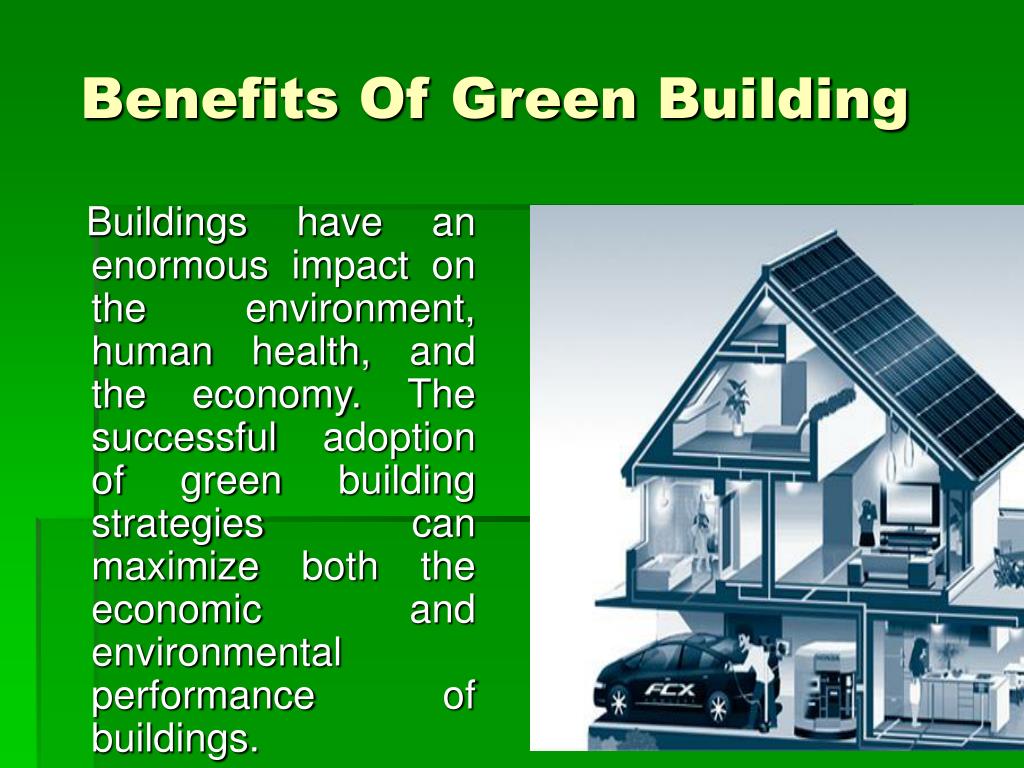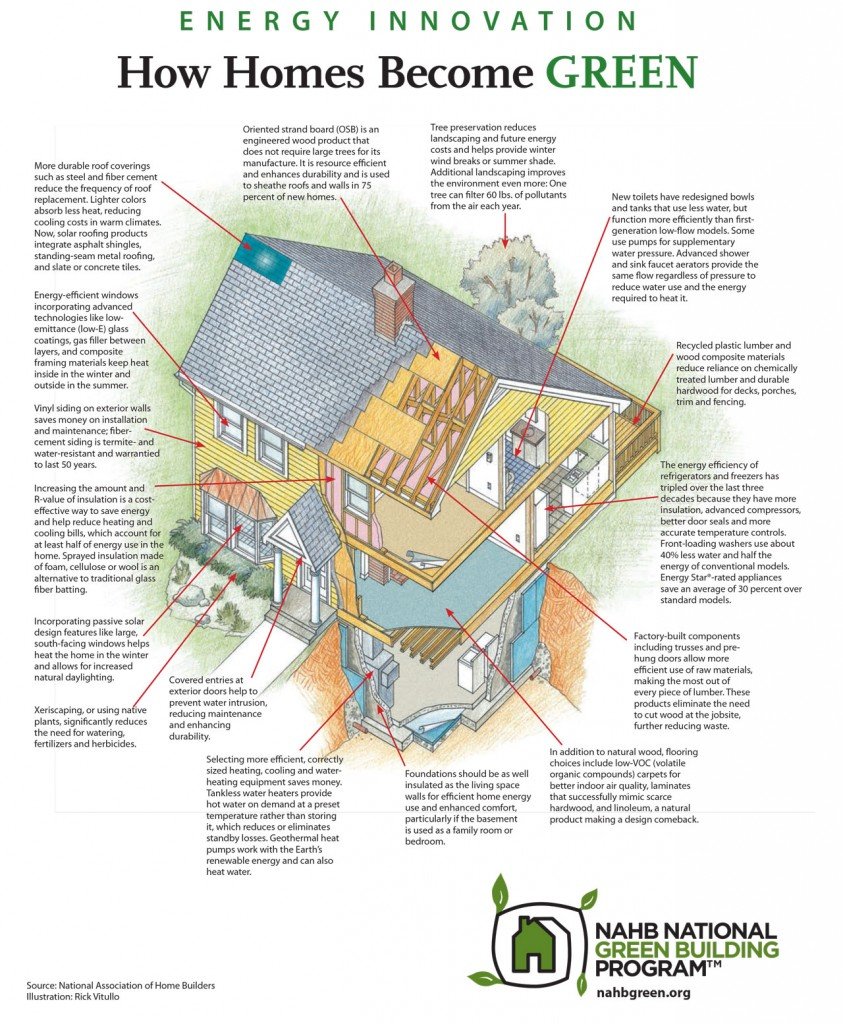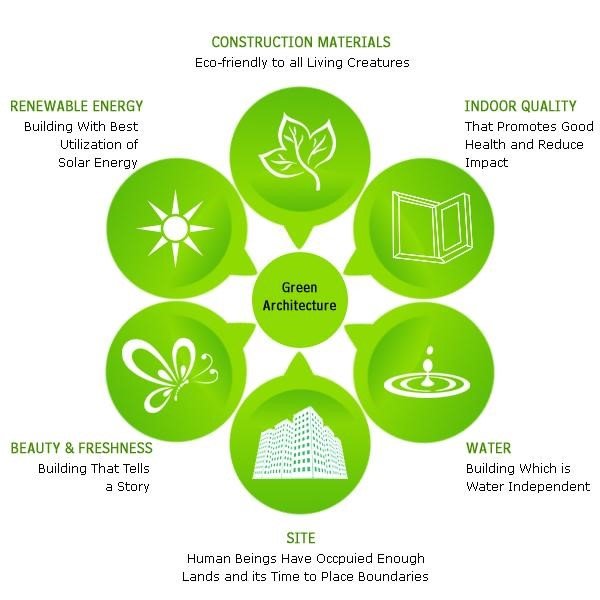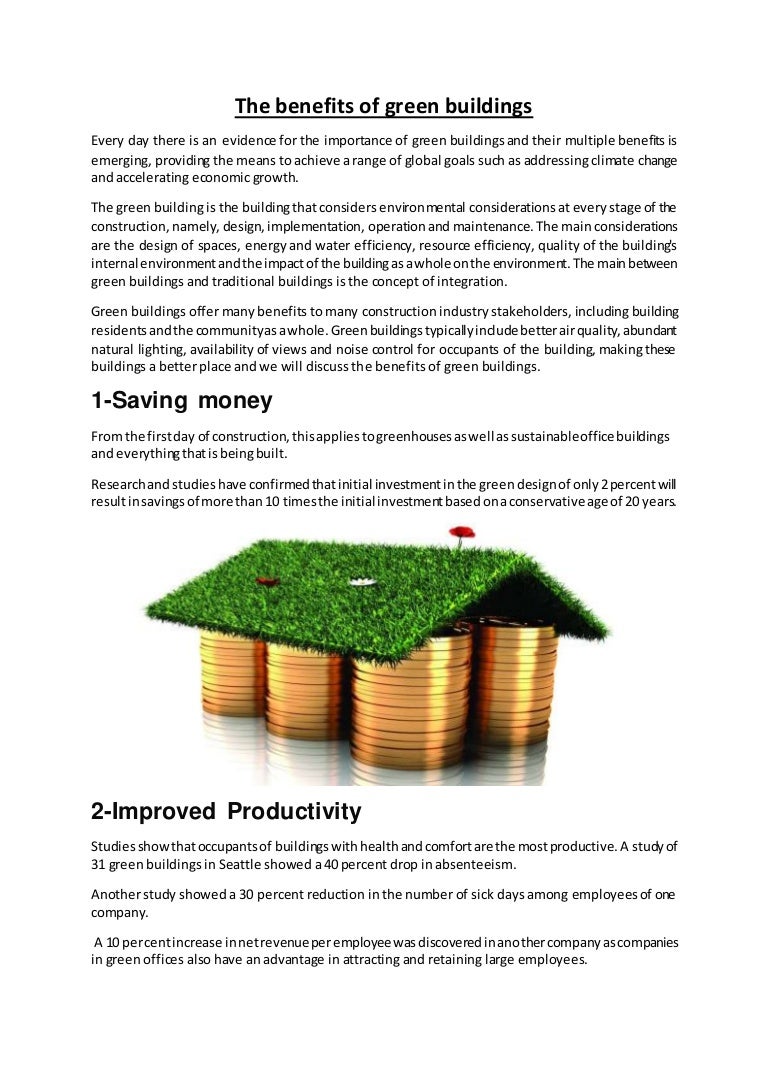Benefits of green buildings
Green buildings help reduce negative impacts on the natural environment by using less water, energy, and other natural resources; employing renewable energy sources and eco-friendly materials; and reducing emissions and other waste.
What considerations make a building considered to be a green building?
1. Building materials: Building with reused, recycled, biodegradable, or carbon storing materials are used in many green buildings. 2. Emissions reduction: Green buildings make use of renewable energy sources such as rooftop solar and a smart grid, heat pumps for heating and cooling, and solar water heaters.
What are the five factors to be considered in construction of a green building?
- Livable communities.
- Energy efficiency.
- Indoor air quality.
- Resource conservation.
- Water conservation.
What are the three important features of a green building?
Some of the more common features of green buildings include: Energy Efficiency. Renewable Energy Generation. Water Efficiency.
What are the benefits of green building in construction?
- Improved Indoor Environment: Quality of Life.
- Saving Water: Reduce, Reuse, Replenish.
- Enhanced Health: Eco-Friendly For Life.
- Reducing The Strain: Shared Resources, Increased Efficiency.
- Reduced Operational Cost and Maintenance: Traditional vs.
- Energy-Efficient: Non-Renewable vs.
Why is LEED building important?
LEED-certified buildings implement design and system selections that reduce energy usage, improve indoor air quality, and protect natural ecosystems. These can include exterior features such as stormwater management elements like green roofs and native landscaping.




A short note on Steel
— Ayush Agrawal Research (@iMicrocap) July 5, 2023
Steel is a strong material that is used to build many things, like cars, buildings, and bridges. But when we make steel, there is a gas called carbon dioxide that gets released into the air, and that's not good for our planet.
Decarbonization of steel means…
Why is the green building rating system important?
Green rating systems focus attention on project goals, means and methods. Green projects are better prepared to mitigate the severe impacts of natural disasters. These projects are also better designed to prevent losses from fire and plumbing damage and withstand unpredictable energy prices.
Frequently Asked Questions
Is LEED building certification worth it?
Resale Value: LEED-certified buildings can have a higher resale value compared to similar non-certified buildings. The certification signifies that the building is well-constructed and will be more efficient to operate, making it more attractive to potential buyers.
How much is CoConstruct software?
CoConstruct Pricing Overview
| Name | Price |
|---|---|
| Standard | $99.00Per Month |
| PLUS™ | Starting at $399.00Per Month |
Which software is used by construction company?
1 Procore - Best Overall
The tool lets construction companies know what needs to get done to stay on schedule, and lets you identify issues before they impact your budget or schedule. Procore states that 75% of construction project managers reduce project duration by at least 3 days using their program.
What makes a builder a green builder?
A green builder will choose building materials made from recycled materials and derived from renewable raw materials; consider the energy efficiency, recyclability, and length of service life of the materials; and often use materials produced locally.
What are green practices in construction?
Sustainable construction is the practice of creating a healthy environment that's based on ecological principles. According to Professor Charles J. Kibert, sustainable construction focuses on six principles: “conserve, reuse, recycle/renew, protect nature, create nontoxic and high quality.”
What are green principles for construction?
Green construction practices are methods and procedures that minimize the environmental impact and maximize the efficiency of the construction process. They include site protection, erosion control, stormwater management, waste management, pollution prevention, and quality control.
What is the difference between a green building and a normal building?
Conventional buildings have traditionally been built using bricks, concrete and steel; however, green buildings use materials that are earthly. This includes everything from timber, stone and straw (depending on the climate and region).
What are the requirements to be a LEED Green Associate?
What is LEED experience?
A LEED credential denotes proficiency in today's sustainable design, construction and operations standards. More than 203,000 professionals have earned a LEED credential to help advance their careers. Showcase your knowledge, experience and credibility in the green building marketplace as a LEED professional.
How do I meet LEED requirements?
- Minimum Program Requirement #1: Must be in a permanent location on existing land.
- Minimum Program Requirement #2: Must use reasonable LEED boundaries.
- Minimum Program Requirement #3: Must comply with project size requirements.
How difficult is the LEED Green Associate exam?
Taking a LEED AP Exam can be intimidating; after all, it's a very difficult process to go through. Here at GBES, we are proud of our 95% pass rate for students attempting to pass the FIRST time. In order to help candidates along that process, here are some key tips and tricks to doing just that.
FAQ
- How long should I study for LEED Green Associate?
With GBRI's study materials, you can earn your LEED Green Associate credential in as little as 5 weeks. Based on your schedule, attend the 4 week instructor-led live exam prep sessions OR utilize self-paced online on-demand exam prep modules.
- Why would a project team use low emitting materials?
To reduce concentrations of chemical contaminants that can damage air quality and the environment, and to protect the health, productivity, and comfort of installers and building occupants.
- Which project layout would be best for reducing demand for new materials?
- Mixed-use projects such as putting apartments on top of retail stores reduce materials because the project isn't building separate buildings for residential and retail. Less buildings means less new materials.
- Which of the following must occur before a project team pursues a LEED interpretation?
Which of the following must occur before a project team pursues a LEED Interpretation? The inquiry must first undergo the project CIR process.
- Which LEED category includes credits for improved rainwater management and heat island effects as well as reductions of light pollution?
In LEED v4, the SS category combines traditional approaches with several new strategies, including the backlight-uplight-glare (BUG) method (Light Pollution Reduction credit), working with conservation organizations to target financial support for off-site habitat protection (Site Development—Protect or Restore Habitat
- What are low-emitting materials for construction?
Materials with naturally low VOC emissions include stone, ceramic, glass, concrete, brick, plated or anodized metals, and unfinished/untreated solid wood—though this may not be the case if these contain any integral organic-based surface coatings, binders, or sealants.
- What are the five areas of construction in which LEED credits can be earned?
How LEED works. To achieve LEED certification, a project earns points by adhering to prerequisites and credits that address carbon, energy, water, waste, transportation, materials, health and indoor environmental quality.
- What are the 5 categories of LEED?
- The five different LEED AP specialties offered by the United States Green Building Council (USGBC) are as follows;
- LEED AP BD+C (Building Design + Construction)
- LEED AP ID+C (Interior Design + Construction)
- LEED AP O+M (Operations + Maintenance)
- LEED AP ND (Neighborhood Development)
- LEED AP Homes.
- What are the five major performance areas of LEED?
As a LEED-certified project, you have access to Arc, a platform that allows you to meet LEED energy and water data tracking requirements (post certification) and manage performance across five areas: energy, water, waste, transportation and human experience.
- What are the 6 LEED credit categories?
- LEED: Certification Pathways and Categories
- Integrated Process.
- Location and Transportation.
- Sustainable Sites.
- Water Efficiency.
- Energy and Atmosphere.
- Materials and Resources.
- Indoor Environmental Quality.
- Innovation.
- What are LEED building credits?
A building is LEED-certified once it has achieved a certain number of credits—which then earn points—by implementing green building practices that address carbon, energy, water usage, waste, transportation, materials, and health and indoor environmental quality, according to the United States Green Building Council (
Which of the following would not be considered to offer benefits in green building construction
| What LEED category can the most points be obtained? | How LEED works
|
| Which LEED rating system would be used when building a new building? | (BD+C) LEED for Building Design and Construction (BD+C)This rating system is for buildings that are new construction or major renovations. At least 60% of the project's gross floor area must be complete by the time of certification (except for LEED BD+C: Core and Shell). |
| What is the highest LEED certification a building can obtain? | Platinum LEED Platinum Platinum. LEED Platinum is the highest level of certification in the LEED program. In order to achieve this impressive score, a home must receive 80 or more points on the LEED scorecard. |
| What is LEED for new construction? | LEED (Leadership in Energy and Environmental Design) is the most widely used green building rating system in the world. Available for virtually all building types, LEED provides a framework for healthy, efficient, and cost-saving green buildings. |
| What is the highest score on the LEED? | A LEED performance score of 40–49 means you're performing at the LEED Certified level, 50–59 corresponds with LEED Silver, 60–69 corresponds with LEED Gold and 80+ corresponds with LEED Platinum. A score of 100 means your building is net zero in energy, water and waste. |
| What does LEED mean in construction? | Leadership in Energy and Environmental Design LEED (Leadership in Energy and Environmental Design) is the world's most widely used green building rating system. LEED certification provides a framework for healthy, highly efficient, and cost-saving green buildings, which offer environmental, social and governance benefits. |
| What is the LEED material and resources category? | The Materials and Resources (MR) category is about minimizing the energy and environmental impacts associated with the extraction, processing, transport, maintenance, and disposal of building materials. |
| Is concrete LEED certified? | Concrete Helps Achieve LEED™ Certification
Using concrete in various applications can help a project earn up to 110 LEED™ points, and 40 points are needed for basic LEED certification. In the LEED checklist below, click on the credit below to see how concrete may qualify for the credit. |
| What is LEED certified flooring? | There's no such thing as LEED certified flooring. LEED certifies buildings, not products or manufacturers. Therefore, you can't exactly buy and install a floor that is LEED certified. However, LEED flooring options can add credit to your LEED application and help you achieve LEED certification. |
| What is an example of a LEED building? | Willis Tower – Chicago, Illinois
Standing at 442.3 meters tall, it dominates the Chicago skyline, and is a prime example of how the LEED system can be successfully implemented within existing buildings. |
- What does it mean to be LEED certified hotel?
The LEED green building certification program provides the framework for building and operating hotels sustainably. Green buildings use on average 26% less energy, emit 33% less carbon dioxide, use 30% less indoor water, and send 50%‐75% less solid waste to landfills and incinerators.
- How do I become LEED certified?
LEED certification involves a few steps.
Register your project at LEED Online and pay the registration fee to demonstrate your commitment. Prepare and submit your certification application for review by CAGBC along with a certification fee. After a detailed review, projects receive the decision.
- How fast can you get LEED certified?
This process usually takes 20-25 business days.
- What is the first qualification for LEED certification?
Professionals interested in LEED green buildings usually study LEED standards in preparation for an accreditation exam. Upon passing the exam, the individual earns a LEED Green Associate credential or a LEED Accredited Professional (AP) credential and is then said to be LEED accredited.
- Is LEED certification hard to get?
Taking a LEED AP Exam can be intimidating; after all, it's a very difficult process to go through. Here at GBES, we are proud of our 95% pass rate for students attempting to pass the FIRST time. In order to help candidates along that process, here are some key tips and tricks to doing just that.
- How much money do LEED buildings save?
Lower energy bills and upkeep costs
Lower energy usage and costs are the most well-known benefits of LEED certification. On average, LEED buildings use 25 percent less energy, and have 19 percent lower maintenance costs than non-certified facilities.
- Is a benefit of a LEED certified home?
LEED-Certified Home Benefits
LEED-certified homes are designed to provide clean indoor air and ample natural light and to use safe building materials to ensure comfort and good health. They help reduce energy and water consumption, thereby lowering utility bills each month, among other financial benefits.
- Does LEED certification increase property value?
LEED Real Estate Benefit #2: Increased Property Value
Studies show that LEED-certified properties command higher rental rates and resale values than their non-certified counterparts. This translates to long-term value for construction companies and their clients.
- Is LEED certification worth the cost?
Resale Value: LEED-certified buildings can have a higher resale value compared to similar non-certified buildings. The certification signifies that the building is well-constructed and will be more efficient to operate, making it more attractive to potential buyers.
- Are LEED buildings cheaper?
- Construction-related expenses for LEED-certified buildings can increase a project's cost by about 10 to 30 percent. LEED certification alone can account for 5 to 15 percent of the total construction costs, not including funds required for other mandated expenses.

